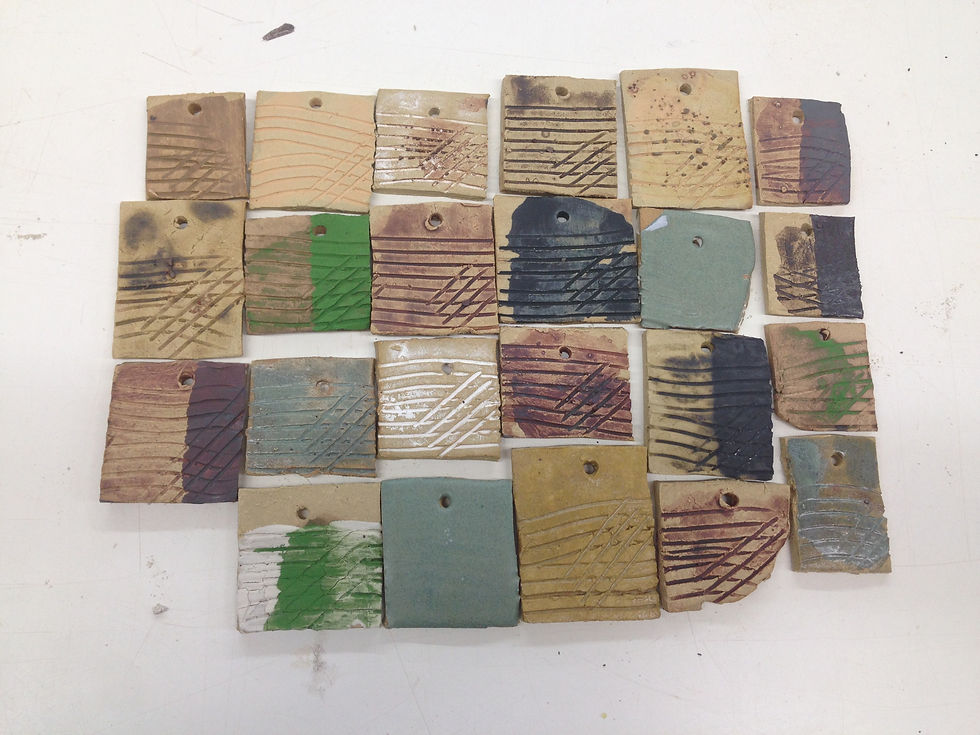Paint Effects
- kathrynstevens
- Jun 8, 2021
- 3 min read
Updated: Jul 14, 2021
Need to try to see how I can incorporate glaze, oxides, slip and texture into the decoration of my work.
I have researched the effects of oxides on test tiles either on there own or with brick clay liquid (not slip as it is too over powering) and over non-fired porcelain slip. It is my understanding that slip does not adhere to bisque fired clay so it will be intriguing to see what happens.
I thought it would be useful to see what happens with Tin Oxide and Titanium Oxide underneath my glaze recipes as I have been told that you can get some astonishing results with layering.
The results were surprising. First of all I was shocked that the porcelain slip adhered to the bisque fired clay, however on further handling some of it did flake away on two of the test tiles. Aesthetically this does not cause an issue as it adds to the flaky paint effect, however it questions my robustness of the finished work.
These are the test tile results I have dismissed and do not wish to explore further.

My preferred test tile results are below. Picture 1 shows examples of subtle and delicate finishes from the oxides providing flashes of shine resembling the sun shining on the sea. Where the oxide has been applied thickly inside the groves of the texture it has created its own flaky texture as if it has been rotten by years of decay. I appreciate the mottled look of the finishes and the addition of fired clay adding further texture. Picture 2 shows the results of the porcelain slip fired on bisque tiles. The texture has enhanced the flaky appearance of the slip which is why I think it has been successful. The oxides have further extenuate the created texture. Picture 3 shows the mottled glazes due to rutile, I particularly like the golden tone in the top left tile.
The other tests I have undertaken this week are printing techniques using slip on leather hard slabs.
Picture 1 - bubble wrap
Picture 2 - crumpled newspaper dabs
Picture 3 - paper on texture
Picture 4 - paper transferred with rolling pin
Picture 5 - paper towels after leaving the slip to dry abit first
Picture 6 - sponge dabs and strokes
Picture 7 - newspaper with slightly dry slip
Initially my thoughts are that I get better results when the slip is drier on application using paper as the method wiping with the hand but want to see the results dry first before offering conclusions.
I tried layering more glaze on the paper using dried slabs. The first picture shows the results when I remove the paper once I has sponged the back, not good results. The slip transfer was a gooey mess and provided little texture. The results of my second experiment, which involved leaving the paper on the slab until the paper was dry was much more productive. As shown in picture 2 there is an organic texture left behind. If applied to texture it created holes underneath and undercuts as seen in the rotten wood samples. Just what I am after!
I also experimented with layering different coloured slips in various application methods, preferring the crumpled up paper to crack the slip and provide an organic looking finish when applied to the dry slab.
My favourite two results have been fired to take them onto the next stage of applying oxides and glazes to see how the finish is effected. I am interested to know how the application of wet slip on bone dry slabs behave in the kiln.
The fired pieces have come out well. They produce a flaky appearance but are robust once fired, ie they do not come off the piece. This is definitely worth further exploration.























































Comments